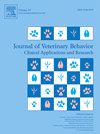Gaddi山羊的行为适应:喜马拉雅西北地区季节性资源利用的验证
IF 1.3
3区 农林科学
Q4 BEHAVIORAL SCIENCES
Journal of Veterinary Behavior-clinical Applications and Research
Pub Date : 2025-03-01
DOI:10.1016/j.jveb.2025.02.003
引用次数: 0
摘要
本研究考察了印度喜马偕尔邦喜马拉雅地区游牧放牧管理下的加迪山羊(Capra hircus)的行为适应性。加迪牧民的季节性迁徙与繁殖周期和饲料供应一致。目的是探索季节性迁徙和传统牧区决策如何与关键生殖阶段(妊娠中期(MP)、孕后(PK)和哺乳期中期(ML)相一致,以优化资源利用并确保山羊福利。行为模式记录在三个垂直区域:高山丘(>1800 m),中山(651-1800 m)和低山丘(350-650 m)。在两条迁徙路线上对4只羊(n=248±15.1)进行了观察,采用焦点采样和录像的方式记录了8 h放牧期间的行为。数据采用SPSS单因素方差分析。结果表明:ML组总摄食时间(58.77%)高于PK组(56.33%)和MP组(54.58%),p < 0.05;ML期间浏览时间最多(45.87%),MP期间放牧时间最多(46.18%)。MP和PK组站立时间显著高于ML组(P<0.05),行走、反刍和躺卧时间无显著差异。在开玩笑期间,两足站立和物体梳理的频率最高,而在开玩笑后,自我梳理的频率最高。研究结果强调了牧民的决定如何与Gaddi山羊的生理需求相一致,从而提高了它们的适应性、资源利用率和福利。行为观察证实了传统的迁移做法,并提出了优化山区牲畜管理的途径本文章由计算机程序翻译,如有差异,请以英文原文为准。
Behavioral adaptations of Gaddi Goats: Validation of seasonal resource utilization in transhumant pastoralism of the North-western Himalayan region
This study examines the behavioral adaptations of Gaddi goats (Capra hircus) managed under transhumant pastoralism in the Himalayan region of Himachal Pradesh, India. Seasonal migrations by Gaddi pastoralists align with reproductive cycles and forage availability. The objective was to explore how seasonal migrations and traditional pastoral decisions align with key reproductive stages—mid-pregnancy (MP), post-kidding (PK), and mid-lactation (ML)—to optimize resource utilization and ensure goat welfare. Behavioral patterns were documented across three altitudinal zones: high hills (>1800 m), mid hills (651–1800 m), and low hills (350–650 m). Observations were conducted on four flocks (n=248±15.1) along two migratory routes, documenting behaviors over 8-h grazing periods using focal sampling and video recordings. Data were analyzed using one-way ANOVA in SPSS. Results showed total feeding time was highest (P<0.05) during ML (58.77%) compared to PK (56.33%) and MP (54.58%). Browsing time peaked during ML (45.87%), while grazing was most prominent during MP (46.18%). Standing time was significantly higher (P<0.05) at MP and PK compared to ML, with no significant differences in walking, ruminating, or lying. Bipedal stance and object grooming were highest during ML, while self-grooming was most frequent post-kidding. The findings highlight how pastoral decisions align with the physiological needs of Gaddi goats, enhancing their adaptability, resource utilization, and welfare. Behavioral observations validate traditional transhumant practices and suggest pathways for optimizing livestock management in mountainous terrains.n
求助全文
通过发布文献求助,成功后即可免费获取论文全文。
去求助
来源期刊
CiteScore
3.50
自引率
16.70%
发文量
107
审稿时长
325 days
期刊介绍:
Journal of Veterinary Behavior: Clinical Applications and Research is an international journal that focuses on all aspects of veterinary behavioral medicine, with a particular emphasis on clinical applications and research. Articles cover such topics as basic research involving normal signaling or social behaviors, welfare and/or housing issues, molecular or quantitative genetics, and applied behavioral issues (eg, working dogs) that may have implications for clinical interest or assessment.
JVEB is the official journal of the Australian Veterinary Behaviour Interest Group, the British Veterinary Behaviour Association, Gesellschaft fr Tierverhaltensmedizin und Therapie, the International Working Dog Breeding Association, the Pet Professional Guild, the Association Veterinaire Suisse pour la Medecine Comportementale, and The American Veterinary Society of Animal Behavior.

 求助内容:
求助内容: 应助结果提醒方式:
应助结果提醒方式:


